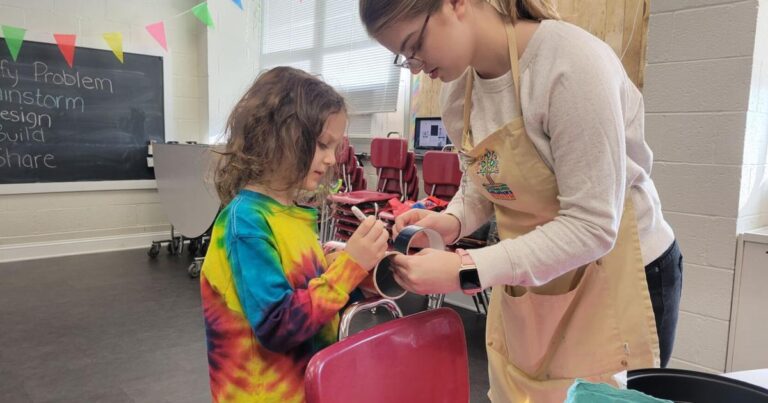LEWISBURG — Young thinkers used Pringle cans, pool noodles and lots of tape and hot glue to create their own prosthetic legs at the Lewisburg Children’s Museum on Monday.
The STEM (Science Technology Engineering Mathematics) engineering activity challenged students to become more empathetic individuals while learning about and designing an interchangeable prosthetic leg. Three children attended the workshop at the former Lewisburg Area High School building located at 815 Market St.
“Whenever there’s a real-world scenario that the kids can tackle, and there’s a problem to solve, there’s excitement in that,” said Kahla DeSmit, director at Lewisburg Children’s Museum. “They had an attitude of ‘Oh, we can do this.’”
The workshop started with a video of Mike “Monster Mike” Schultz, whose left leg was amputated following a professional snocross race accident in 2008. After being fitted for a prosthetic, he noticed the fake leg didn’t absorb the same way his real leg did when he returned to BMX.
According to the International Paralympic Committee, “He engineered his own prosthetic knee and got back into sports, winning a silver in motocross adaptive at the X Games. Schultz saw the need for advancements in prosthetics, leading him to found BioDapt Inc. in July 2010. His products have been instrumental in the development of prosthetics for action sports athletes and wounded soldiers, and he has been working on an improvement to the Versa Foot, which was named one of the Top 10 Inventions of 2013 by Popular Science magazine.”
“He is a great example of how to think through and approach a problem and work like a scientist,” said DeSmit. “This is a fun, low stress environment for the kids to test out scientific thinking.”
The children brainstormed through ideas, worked out a design on paper, used the materials in the classroom to build their model, tested it out and shared their results with the other students. DeSmit said she warned the students that their models may not work as intended in the end, but encouraged them to continue to modify their design.
It took Schultz two months to build his own leg, she noted.
Materials included tissue boxes, Pringle cans, egg cartons, plastic jugs, pool noodles, hot glue and tape.
Aidric Stone, 8, of Lewisburg, said a “gigantic cardboard foot” would make it easier to walk and balance. Aidric used packaging and pool noodles to make it comfortable for the knee.
“And it worked,” said Aidric. “I used a bunch of duct tape and regular tape.”
Aidric said the lesson is “Everything you build doesn’t always work.”
The Pringle cans looked like the strongest material, said Aidric.
Weston Makuch, 8, of Danville, originally used pool noodles and tissue boxes, but he added Pringle cans at the end because the pool noodles didn’t offer up enough support.
“The pool noodles are the bounciest, and it would help,” said Weston. “The tissue boxes I used for the foot and I thought it would be a good box for my foot to fit in.”
Weston’s mother, Heather Makuch, has been a board member of the museum since May but she has been bringing her son to the museum for years.
“There’s something for every kid to do,” she said. “It’s an inclusive environment. Every time they come they play a different way.”
Weston looks forward to programs where he can craft. He especially loves building with Legos.
“It’s his favorite,” said Makuch.



